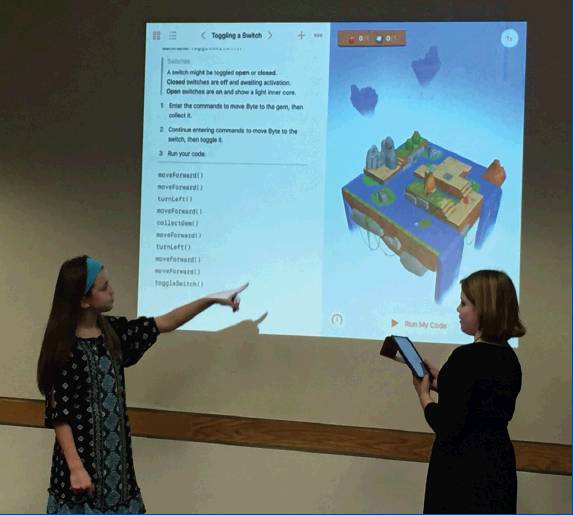Elizabeth Forward students tech savvy
Five elementary students showed examples of how much technology education is being offered in the school district.
By JOSE NEGRON jnegron@yourmvi.com
Five Central Elementary school students attended the Elizabeth Forward School Board meeting to highlight some of the technology initiatives the district offers. Much of the information involved computational thinking, which involves formulating solutions to problems in ways computers can carry them out. “We need to teach kids about computational thinking and computer science at an early age, so as they go into high school they’ll have some experience that they can take to higher-level computer science classes,” Assistant Superintendent Dr. Todd Keruskin said at the Wednesday meeting. “We’ve really been working hard with our teachers.” District technology specialist Ward Cochenour works with students in the district’s four elementary schools. Cochenour introduced first-graders Lucas Maksin, Sophia Gidel and Bryce Borkowski and fifth-graders Giovanna Ferraro and Sydney Toth. Maksin, Gidel and Borkowski showcased a computational-thinking program known as “Beebots.” The program, one of many for students in kindergarten through grade two, involves two components. One allows students to solve problems with the correct answers located on different mats. The students then enter codes – through buttons on the backs of Bee robots – to navigate them to different areas on a mat. Cochenour said the mats include teaching points such as middle sounds. “When they are learning middle vowel sounds, they can use the Beebots for the kids to indicate if they are looking for a picture with a short “A” sound. They have to know the answer to be able to navigate,” Cochenour said. “All of the mats have lots of different activities that they can do.” Cochenour said the biggest thing children learn through the activity is spatial relationships. “They are used to using up, down, left and right, but they’re not used to actually turning something and then having to move forward,” Cochenour said. “This really gets that concept across to them. It’s a much more precise way of them thinking.” Keruskin said the program teaches children at an early age about sequence, how programming works and how to solve problems. Another component, “Puzzlet,” involves virtual characters on an iPad app. Students are given objectives such as collecting puzzle pieces and raindrops, and they must have a certain amount of water droplets to move on. The virtual component is taught in kindergarten and first grade. The first-graders showcased an online activity known as “Kodable,” designed for students in kindergarten through grade five. The activity involves various types of programming, including basic commands, but gets into higher levels. The students navigate characters around puzzles in exercises to promote concentration. “It is amazing to see kids working on this when you walk into a classroom,” Keruskin said. “They don’t even pick their heads up. They’re so engaged.” Ferraro and Toth showcased two programs. The first was a site called “Code.Org,” an online program in which students enter codes to navigate characters through puzzles in various stages. The goal is to use blocks of instructions to tell the characters what to do. “The kids are learning coding, but through block codes,” Keruskin said. “It’s a little bit different from what they were learning in (kindergarten through second grade). They can get very complex.” The fifth-graders also demonstrated swift coding, which allows them to advance from block coding to actual programming language. “One of the activities we did to introduce it to the fifth-graders is to use carpet squares and written coding instructions to figure out how they would get from block to block on the floor,” Cochenour said. “This is the physical part of it.” Swift coding is the step between block coding and script coding.
“We’re moving away from the Beebots, the block coding and now they’re actually writing lines of code in fifth grade,” Keruskin said. “In the middle school, they will take it to another level. “Our goal is to make sure this happens across the district at all of the schools.” The final presentation by the fifth graders involved a virtual world in which the students navigate a character named “Byte,” who must collect gems and accomplish tasks at various levels. With so many programs offered to students from kindergarten to fifth grade, Cochenour said he sees children developing better concentration and advanced skills at a young age. “You can see with the students we had here, once they get started on it, the room gets pretty quiet and they are very focused,” Cochenour said. “For the kids, the computational thinking helps in math and science because they are starting to think differently. That’s a really big step for them.” The Elizabeth Forward School District is part of the Digital Promise League of Innovative Schools, which involves 70 districts across the country. The district has been recognized as an Apple Distinguished School District.
“It is amazing to see kids working on this when you walk into a classroom. They don’t even pick their heads up. They’re so engaged.”
DR. TODD KERUSKIN
ASSISTANT SUPERINTENDENT
